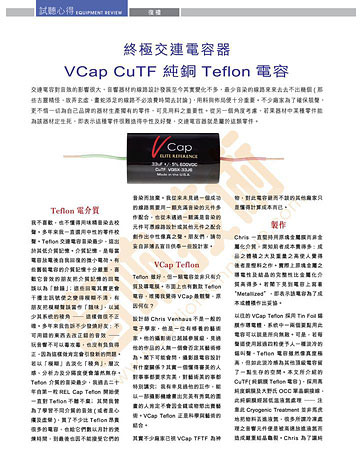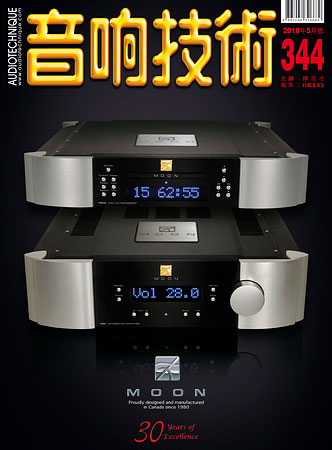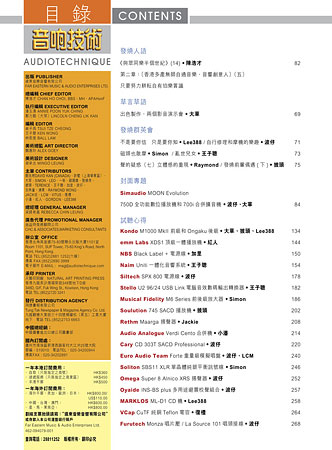|
|
||||||||
Below, is an English translation of the V-Cap CuTF review, courtesy of AudioTechnique Magazine. AudioTechnique is a well respected audiophile equipment review magazine that is published monthly in Hong Kong. For a subscription, please visit AudioTechnique's website. ____________________________________ The Final Coupling Capacitor Foreword Fluoropolymer Dielectric I have never heard a circuit requiring a component with some sort of coloration become a neutral-sounding circuit. I’ve never heard a component with coloration that, after matching with certain circuits or other components, can create neutral and true music. Dear friends, do not depreciate yourself and blindly worship those famous brands’ designers. V-Cap Fluoropolymer The designer of V-Cap Fluoropolymer, Mr. Chris VenHaus, is no ordinary electronic engineer, he is an artist. He is a photographer who has achieved higher-than-exhibition-level photographic skills. Those who have seen the images he makes won’t doubt his artistic background. One may ask, why bother and what is the relation of photography to capacitor design? In fact, all good artists are perfectionists, and have an exceptional artistic sense of beauty. I have seen the images he makes: one who can draw beautiful pictures with a camera will certainly respect music and won’t betray the beauty of arts. Therefore, I feel the V-Cap Fluoropolymer is a perfect combination of art and science. Many top-notch designers consider V-Cap Fluoropolymer as the Holy Grail, others who avoid talking about it are rather cost-conscious. Construction Previously, I used V-Cap TFTF Tin Foil & Fluoropolymer Film capacitors. Using one or two of these Fluoropolymer caps in each channel provided near-perfect sound. However, if one channel uses more than four TFTF caps, this may sound cold and clinical in certain systems, and may provide other exotic capacitors with a tiny bit of living space on the market. This article concerns the latest V-Cap CuTF capacitor, which uses pure copper foil and OCC (Ohno Continuous Cast) single crystal copper leads. The copper foil is cryogenically treated. Note that some Cryogenic Treatment companies immerse components into liquid nitrogen, which lowers the temperature too quickly, causing thermal shock to the conductor. Chris, on the other hand, uses a very expensive cryogenic machine (HK $500,000), which is specifically designed to prevent thermal shock to the material. This machine lowers the temperature of the foil gradually, and evenly with heat exchangers and a specific computerized program that is specifically tailored for this material. This, I call, real cryogenic treatment. From my point of view, cryogenically treating a capacitor is more effective than a cable, owing to the fact that a cable is repeatedly bent and moved (crystalline structure distorted repeatedly), whereas a capacitor’s foil is untouched after the manufacturing process, retaining the benefits of the cryogenic treatment. As for the lead wires, Chris found that the OCC copper conductor doesn’t benefit from cryogenic treatment (a property of OCC perhaps?). The lead wire is insulated with his latest foamed Fluoropolymer insulation (AirLok), which further reduces dielectric constant. As you can see, even the lead wires were seriously evaluated and chosen. I asked Chris whether he had tried silver or silver/gold foil. He commented that these two materials may make the soundstage more forward than it ought to be. Perhaps neutral sounding Fluoropolymer should mate with neutral sounding copper. We may hear friends saying that a system contains “too much silver”, but seldom do we hear “too much copper”. This illustrates copper’s neutrality. Other brands of capacitors may induce microphonics. Perhaps owing to copper’s high atomic mass, we don’t encounter microphonics in Chris’ design. The Fluoropolymer used in the CuTF series was specifically chosen for this capacitor film application. Together with a special custom-made winding machine (the previous Swiss made winding machine for TFTF wasn’t used). The winding tension is perfectly controlled, in order to prevent pores from being created in the film. For some other brands of caps, pores are created during the winding process, causing multiple imperfections on the film- which may be a major cause of rough and grainy sound. Old Russian Teflon caps sound extremely grainy, and I attribute this to film imperfections caused by poor winding. REL Cap may not sound grainy, but the smoothness of sound is still incomparable to the V-Cap. All V-Cap capacitors have a very special winding method, which markedly reduces induction and Eddy current, resulting in a very even frequency spectrum. Other brands of Teflon capacitors may sound overtly-bright. The end-fill material is also a secret component of perfect sound. Besides protecting the capacitor, it was chosen for the most neutral resonant properties. Here is how sensitive our equipment is: Try to stick a dot of Blu Tac or hot glue on different components, and you can completely ruin the sound (try this in your enemy’s system :-)). Many component manufacturers simply “batch test”- testing 1 out of 100 hundred pieces from each lot of finished product. Chris, on the other hand, tests several electrical and physical parameters of each and every CuTF capacitor (at multiple times in the process), to ensure the quality of every individual capacitor. Note that the reliability of a coupling cap is very important- a short-circuited capacitor can damage subsequent stages, the power amp, or the speakers. Every CuTF capacitor is also thoroughly tested again before leaving the factory, by a special screening process designed by Chris, so users can enjoy perfect sound as soon as possible. Many of us know, Teflon caps need a very long run-in period- I have encountered audiophiles who are scared of such a run-in process and dare not try Teflon caps. Chris looks after his customers whole-heartedly. The Sound Nine months ago, Chris sent me 4 pieces of 0.1uF 600V Beta test samples. At that time, I was not informed about the material and construction, in order to prevent bias. I used them in the most proximal part of the system, i.e. the preamplifier and the first stage of the phono amplifier. These are the two most sensitive parts of the entire system. I carefully installed them… then my jaw dropped after hearing the first note playing through the system. The next thing I immediately did was to send an email to Chris, asking whether he had other (higher) capacitances for my system: “Could you please make me some CuTF with higher capacitances?”. He replied: “Not yet”. I gave up asking, and pulled myself together, in order to appreciate what I have on hand- the four pieces of CuTF which descended from Heaven. I am still waiting for a 3.3uF CuTF to be made. The strongest impression is the up-heave of emotion from music. The CuTF conveys a kind of never-perceived before, unsurpassable level of humanity and emotion, in a lossless way. It conveys the color of music without adding its own coloration. The advantages of Fluoropolymer are totally retained. Perfect! There is no more clinical sound. The tonal beauty is definitely beyond description, and this clearly alleviates the regret when I turn on my system after returning home from a live concert- my system gets much closer to a live concert experience. Other capacitors that use other dielectrics may sound quite emotional, but they lack the advantages of Fluoropolymer (solidity, density, neutrality, speed and resolving power). The lower midrange has much more authority and energy. The musical energy from a cello easily strikes a listener’s heart, the deepest part of the heart, along with the tears and blood of the composers and musicians. The listener “resonates” with the composers and musicians. I never realized that Graaf and Magneplanar had such potential and can achieve this level of music reproduction. Many old-style copper audio products may sound less clean and clear than silver products. OCC copper and careful cryogenic processes have given rise to a much more transparent sound, while at the same time preserving the neutrality of copper. There are not many successful cryogenic products, CuTF is certainly “the one”. Microdynamics are extremely rich. To avoid disturbing my baby son, most of the time I can only enjoy music at a very low volume level. Despite such low volume level, everything in the music is still fully conveyed. That’s the result of perfect microdynamics. If a system can only amuse a listener at a high volume level, it is far away from perfection. Conclusion I am still waiting for higher capacitance CuTF’s, while at the same time silently watching those famous audio brands' designers, and how they may avoid the CuTF’s, due to price. They may avoid talking about these, but won’t likely ever find a single excuse, for not using the perfect CuTF. Associated equipment: van den Hul Colibri Platinum phono cartridge, Graham Phantom 2 tonearm, Basis Debut turntable, custom DIY phono and preamp, Graaf GM 200 amplifier, Magneplanar 20.1 loudspeakers and van den Hul pure platinum interconnect cables.
READ MORE REVIEWS of the V-Cap Capacitors
| ||||||||
|
|
||||||||


